Scottish Economic Statistics 2008
This is the ninth edition of the annual publication Scottish Economic Statistics, which is produced by statisticians in the Scottish Government.
B5 chapter five: Household income and expenditure
This chapter explores the distribution of household income across Scotland. Household spending is also examined and compared to the United Kingdom average.
Families in Scotland
There are 2.8 million families in Scotland and Table 5.1 breaks these down into the different family types which live together. In this table a family is defined as 'a single adult or couple living together "as married" together with any dependent children'. This means that there can be more than one family living in a household. A retired pensioner living with his adult daughter and her husband for example, would be defined as two families.
Table 5.1: Number of family units and persons in each family type, 2006-07
Family type |
Persons1 |
Families |
||
|---|---|---|---|---|
Frequency (000s) |
Percentage of persons |
Frequency (000s) |
Percentage of persons |
|
Pensioner couple |
600 |
12 |
300 |
11 |
Single pensioner |
400 |
8 |
400 |
15 |
Couple with dependent children |
1,580 |
32 |
430 |
15 |
Single with dependent children |
440 |
9 |
170 |
6 |
Couple without dependent children |
1,040 |
21 |
520 |
19 |
Single without dependent children |
950 |
19 |
950 |
34 |
All |
5,010 |
100 |
2,760 |
100 |
Source: DWP Family Resources Survey, Households Below Average Income 2006-07 datasets
1 Persons in private households. Does not include, for example, people living in prisons, student halls of residence or homeless shelters.
In terms of number of people, couples with children make up the largest family type in Scotland. Almost a third of people live in this type of family. The next largest family types are adult couples or single people living without children. These two family types both contain around a fifth of the population.
Equivalisation
In many of the income statistics published by the Scottish Government and other bodies, family incomes are adjusted through a process known as equivalisation. This allows incomes to be compared across family groups of different sizes and types. Equivalisation adjusts for the fact that different families require different incomes to achieve a comparable standard of living. A couple living together, for example, require a higher income than a single person, but not double the single person's income. The equivalised income for a large family would therefore be less than their actual income. This adjustment has been carried out on the equivalised incomes which are presented in this chapter.
Income Distribution
Chart 5.1: Equivalised household net disposable income distribution (before housing costs), 1998-99 and 2006-07
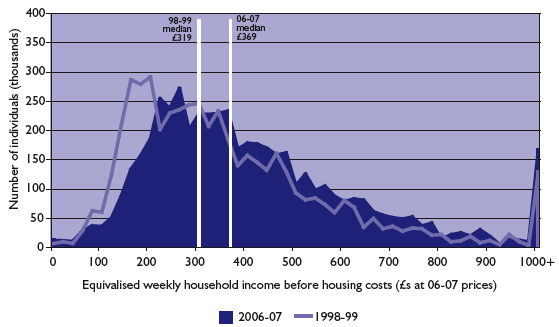
Source: DWP, Family Resources Survey, Households Below Average Income datasets
Chart 5.2: Equivalised household net disposable income distribution (after housing costs), 1998-99 and 2006-07
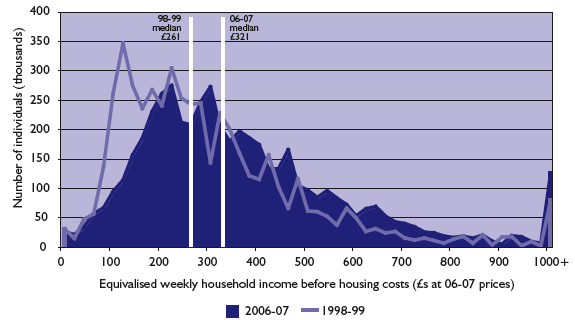
Source: DWP, Family Resources Survey, Households Below Average Income datasets
Charts 5.1 and 5.2 show how the distribution of household income in Scotland has changed between 1998-99 and 2006-07. The 1998-99 figures have been adjusted for inflation and are in 2006-07 prices. In Chart 5.1 the 1998-99 line has a peak around the range £170-£200 which by 2006-07, rose by about £50. This shows that the incomes for many of the poorest people in the 2006-07 distribution were higher than the incomes of the poorest in 1998-99. By examining the graph it is not possible to say whether incomes rose for specific groups of people over this period as it only shows the general distribution of income over the entire population. Tracking of individuals is not possible with these data. It is only possible to say that many of those at the lower end of the income distribution received more in 2006-07 than those at the bottom in 1998-99. This is reflected in the fact that absolute poverty levels, which compare the incomes of the poorest now against what they had in 1998-99 have fallen. In 1998-99, 980 thousand people in Scotland (around twenty per cent of population) were in absolute poverty before housing costs. By 2006-07, this figure had fallen to 510 thousand people (around ten per cent of the population).
However, as well as the increase in incomes of the poorest, the rest of the income distribution has also shifted 'to the right' and the number of people earning over £1,000 per week has increased. This means that the median income has increased by £60 since 1998-99 so the poorest would need more money to 'keep up with' the rest of society. Relative poverty levels which compare individuals' incomes against the contemporary UK medians have shown some reduction, particularly in child poverty, but this has been less dramatic than that in absolute poverty. The proportion of individuals in relative poverty (before housing costs) fell from twenty to seventeen per cent over this period. The fall in the proportion of children in relative poverty was more dramatic, from twenty-eight to twenty-one per cent, but still less than the corresponding fall in absolute poverty.
Chart 5.2 which presents the after housing costs ( AHC) income distributions shows a similar pattern to that for before housing costs income. For most groups, trends in before and after housing costs poverty are similar. The exception to this is pensioners for whom reductions in after housing costs poverty have been more dramatic than for before housing costs ( BHC). Between 1998-99 and 2006-07 the proportion of pensioners in BHC relative poverty fell from twenty-six to twenty per cent, over the same period the proportion of pensioners in AHC relative poverty fell from twenty-seven to fifteen per cent. 1
Income analysis by decile
Another way of looking at the income distribution is to examine the characteristics of each of the ten income deciles. The deciles are formed by sorting the entire population by their incomes and then splitting them into ten equally sized groups. The first decile then contains the tenth of the population with the lowest incomes, the second contains those with the next lowest incomes and the tenth decile contains the tenth of the population with the highest incomes.
Table 5.2 presents information about each of the deciles in the income distribution such as the median income and the cut off point ( i.e. the highest income in each decile).
Table 5.2: Median equivalised net disposable annual incomes before housing costs, total incomes and thresholds by decile: 2006-07
Decile |
annual income |
Decile median Cut off point |
Total income for decile (£ million) |
Cumulative percentage of total national income |
|---|---|---|---|---|
1 |
£7,920 |
£10,070 |
£3,450 |
3 |
2 |
£11,390 |
£12,416 |
£5,670 |
8 |
3 |
£13,550 |
£14,512 |
£6,770 |
14 |
4 |
£15,770 |
£17,009 |
£7,910 |
21 |
5 |
£18,100 |
£19,203 |
£9,030 |
29 |
6 |
£20,600 |
£22,043 |
£10,330 |
38 |
7 |
£23,590 |
£25,312 |
£11,800 |
48 |
8 |
£27,310 |
£29,783 |
£13,720 |
60 |
9 |
£32,970 |
£37,128 |
£16,500 |
75 |
10 |
£45,190 |
none |
£28,750 |
100 |
Source: DWP Family Resources Survey, Households Below Average Income 2006-07 datasets
The decile median is the 'middle' income for each decile. Half the incomes in the decile will be higher than it and half will be lower. For example, half of the people in the second decile (which by definition contains one tenth of the population, roughly 500,000 people) will have annual equivalised incomes below £11,390 (before housing costs).
As would be expected the total amount of income received by the people in each decile increases as we examine higher deciles. Those in the top three deciles receive £59 billion annually, equivalent to over half of the total national household income. In comparison, those in the bottom three deciles receive
£16 billion between them, fourteen per cent of total income.
The Scottish Government's solidarity target 2 directly concerns the lowest three deciles in the income distribution. It is 'To increase overall income and the proportion of income earned by the three lowest income deciles as a group by 2017'. This means that, as well as increasing incomes across the income distribution as a whole, the government plans to increase the proportion of total income received by those at the bottom of the distribution.
Box 5.1: UK and Scottish Government household income targets There are several UK and Scottish Government targets and indicators related to household income. Scottish Government targets and indicators The Scottish Government national performance framework contains a number of interlinked targets and indicators which support the Government's purpose of increasing sustainable economic growth. Improving performance in many of the indicators would be expected to have an influence on household income, the following three measures however are directly related to the income distribution: Solidarity Purpose Target:'To increase overall income and the proportion of income earned by the three lowest income deciles as a group by 2017'. The small, independent countries which neighbour Scotland have greater equality of income and significantly lower rates of poverty with higher rates of economic growth. The Solidarity target is designed to ensure that, while meeting the Scottish Government's Purpose of increasing sustainable economic growth, income inequality is also reduced in order to ensure that all of Scotland benefits from increased prosperity. The Government is clear that Scotland will only do better when more people in Scotland do better. National Outcome:'We have tackled the significant inequalities in Scottish society'. National Indicator:'Decrease the proportion of individuals living in poverty'. For more detail on the measures above and the Scottish Government performance framework see the Scotland Performs website: http://www.scotland.gov.uk/About/scotPerforms UK Government child poverty target: In 1999, the UK Government made a commitment to 'halve child poverty by 2010, on the way to eradicating it by 2020'. The Scottish Government are committed to doing everything that they can within the powers available to them to meet this target. |
Types of families by income decile
Chart 5.3 breaks down the people in each income decile by the type of families that they live in. There are several notable features in this chart, for example the proportion of people in childless couples is much higher among the higher deciles than the lower ones. Between thirty and forty per cent of people in the top three deciles are in this type of family compared with seven to ten per cent in the bottom three. The reverse is true of single people with children and pensioner families which are more common towards the bottom of the distribution.
Chart 5.3: Family composition by equivalised income decile - 2006-07
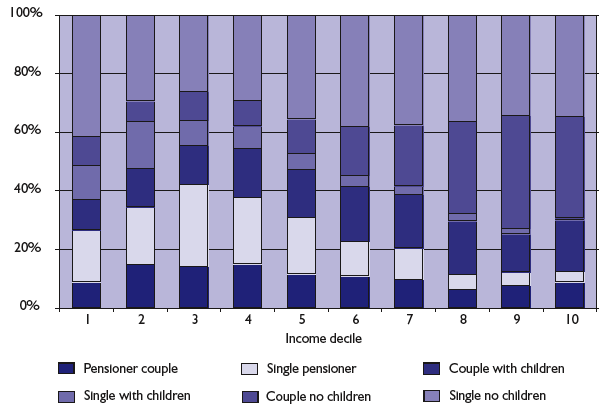
Source: DWP Family Resources Survey, Households Below Average Income 2006-07 datasets
Breaking down the deciles by family economic status again reveals interesting features. As would be expected, Chart 5.4 shows that the proportion of people from families which are workless either because of retirement, unemployment or economic inactivity (people who are neither in work nor looking for work) is much higher towards the bottom end of the income distribution. At the top end of the distribution, the largest group of people come from single or couple families where every adult is working full-time. Over half the people in the top three deciles come from this type of family. It should be noted, however that there are some working families in the bottom decile, and retired and workless families at the top of the distribution.
Chart 5.4: Economic status of family by equivalised income decile - 2006-07
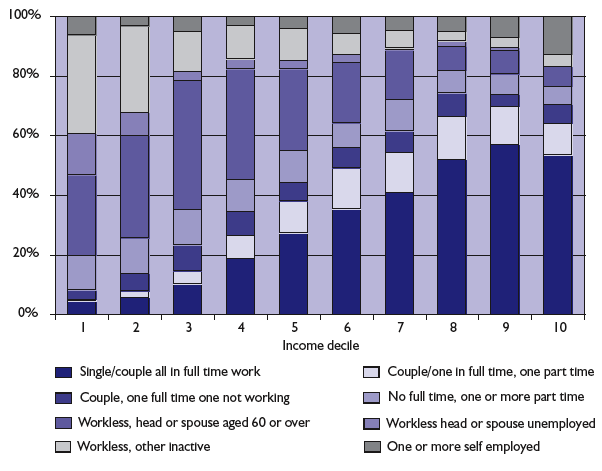
Box 5.2: Income definitions used in this chapter 3 Before housing costs: Net disposable income, equivalised using the before housing costs equivalisation scale. Certain incomes in kind are included such as free school meals and TV licences for over 75s. BHC income is net of income tax, national insurance and council tax as well as certain other payments such as child maintenance. After housing costs: Net disposable income as for BHC but with rent/mortgage payments, water charges, structural insurance premiums, ground rent and service charges deducted. This is equivalised using the after housing costs equivalisation scale. Equivalised net disposable income: 'Equivalised' income is used to allow comparisons of living standards between different household types. Income is adjusted to take into account variations in the size and composition of the household. This adjustment reflects the fact that a family of several people requires a higher income than a single person in order for both households to enjoy a comparable standard of living. The key assumption is that all individuals in the household benefit equally from the combined (equivalised) income of the household. There are distinct equivalence scales used for income before housing costs ( BHC) and income after housing costs ( AHC). Relative low income: Households are in relative poverty if their equivalised income is below sixty per cent of the UK median income of the same year. This is a measure of whether those in the lowest income households are keeping pace with the growth of incomes in the economy as a whole. Absolute low income: Households are in absolute poverty if their equivalised income is below sixty per cent of the GB median in the baseline year, 1998-99, adjusted to remove the effects of inflation. This is a measure of whether those in the lowest income households are seeing their incomes rise in real terms. Median: The income value which divides a population, when ranked by income, into two equal-sized groups. This measure is most commonly used to represent average income due to the highly skewed nature of the income distribution, which leads to the very high incomes of a few having a disproportionate impact on the mean. Decile: The income values which divide the population into ten equal groups when ranked by income. The upper limit of the fifth decile is the median value. Use of GB and UK medians: Since 2002-03 the Family Resources Survey has included Northern Ireland. As a result all relative low income figures from 2002-03 will be calculated using the UK median. Absolute measures utilise a base year prior to the inclusion of Northern Ireland and will therefore continue to use the GB median as the basis for the low income threshold. In practice the change from GB to UK median has little impact on the figures; in 2005-06 the estimated UK median income for a couple with no children is £1 less than the GB estimate for the same year. |
Lorenz curve and Gini coefficient
Another way of examining the distribution of income across a population is by drawing a Lorenz curve. This is a method of graphically presenting the income distribution for an entire population. The cumulative share of total income is plotted against the cumulative share of the corresponding household population. Chart 5.5 presents the Lorenz curve for Scotland in 2006-07. The diagonal line across the centre of the graph represents 'perfect equality of income'. If every household had the same equivalised income then the Lorenz curve would follow this line.
Chart 5.5: Lorenz curve with deciles - 2006-07
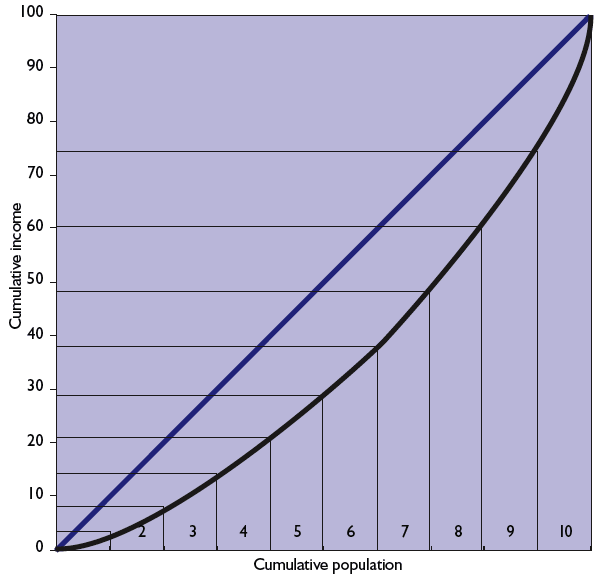
Source: DWP Family Resources Survey, Households Below Average Income 2006-07 datasets
The ten income deciles are marked along the bottom of the graph. The proportion of income received by households in each decile is the height at which the line from each decile intersects the black Lorenz curve. As the Lorenz curve gets steeper towards the top end of the distribution the proportion of income received by those households is larger. The top two deciles receive almost forty per cent of total income while the bottom two receive less than ten per cent.
Another common measure of income equality which is related to the Lorenz curve is the Gini coefficient. This is a figure, which can be derived from the Lorenz curve, that summarises the level of income equality across a population. It ranges from 0 to 100 with 0 representing 'perfect equality' and 100 representing 'perfect inequality' (if one household had all of the income). Chart 5.6 presents the Gini coefficients for Great Britain and Scotland from 1994-95 to 2006-07. Over this period the income has been more equally distributed in Scotland than in GB as a whole. This difference has been slight but consistent since 1994-95.
Historic figures 4 show that the UK Gini coefficient was lower than its current level, and was around 30, towards the end of the 1970s. It then rose throughout the mid to late 1980s and has been at its current level, around 34 to 36, since then. This indicates that at a UK level income was distributed more equally in the late 1970s and early 1980s than it is now. Relative poverty levels were also lower than contemporary levels during this period. Absolute poverty levels however, which compare incomes against the (inflation adjusted) 1998-99 median income, were higher. Thirty-three per cent of the UK population were in absolute poverty before housing costs in 1979 compared with twelve per cent in 2006-07. This indicates that, although income was more evenly distributed in 1979 total income was lower than it is now and many households had lower incomes in real terms.
Chart 5.6: Income inequality as measured by the Gini coefficient (smaller figures signify greater equality) - GB and Scotland 1994-95 to 2006-07
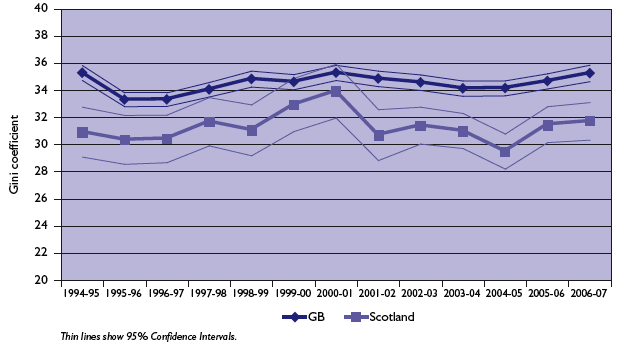
Source: DWP Family Resources Survey, Households Below Average Income 2006-07 datasets
Income source and household assets by income decile
Chart 5.7 below breaks down the various sources of household income by decile. It shows that, as higher deciles in the income distribution are examined, the contribution to household income of earnings increases. This may not be a surprising finding to many people but none-the-less the increase is dramatic.
In the bottom three income deciles between forty-five and sixty per cent of household income comes from the earnings of the householders. In the top three, this proportion rises to almost ninety per cent. In contrast, the contribution of state benefits becomes increasingly unimportant in higher deciles. These make up between nineteen and thirty-five per cent of income in the bottom three deciles and less than three per cent in the top three.
Chart 5.7: Sources of household income by equivalised income decile - 2006-07
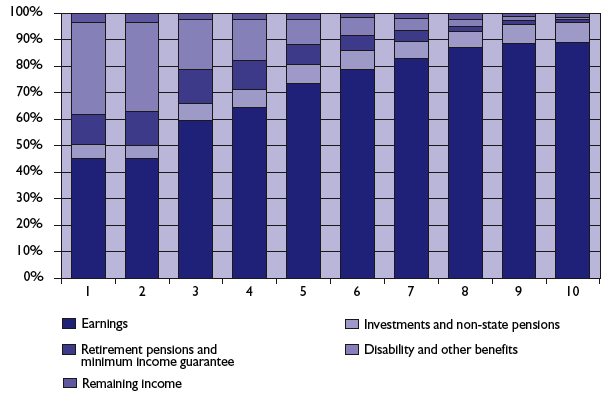
Source: DWP Family Resources Survey, Households Below Average Income 2006-07 datasets
Chart 5.3 shows that the proportion of pensioners is highest in the bottom deciles, but particularly the second, third and fourth. It is notable that the proportion of income from state pensions is also highest in these deciles, as shown in Chart 5.7.
Chart 5.8: Household savings and assets by equivalised income decile - 2006-07
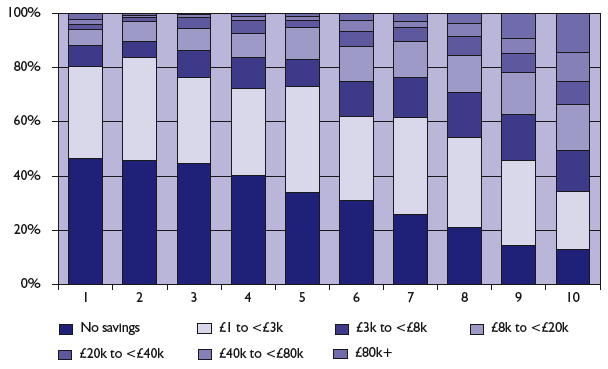
Source: DWP Family Resources Survey, Households Below Average Income 2006-07 datasets
When examining the income distribution it is important to consider savings and assets as well as household income to obtain a more complete understanding of household wealth. The DWP Family Resources Survey asks respondents about their types of accounts and investments. This is used to calculate their total savings and these figures broken down by decile are presented in Chart 5.8. The chart shows that as well as having higher incomes, those at the top end of the income distribution also have more savings to draw upon.
Around forty-five per cent of people in the bottom three deciles have no savings and another thirty per cent have between £1 and £3,000. In the top three deciles thirteen to twenty-one per cent of people have no savings. Around half of people in the top three deciles have savings of more than £3,000 compared with less than a quarter in the bottom three.
Household expenditure
Like assets, household spending is another component of a family's standard of living which is not considered when looking at family income alone. The following table breaks down average weekly spend by commodity group across the four UK nations.
Table 5.3: Household weekly expenditure by commodity and country: 2006
Commodity or service |
Scotland |
England |
Wales |
Northern Ireland |
United Kingdom |
|||||
|---|---|---|---|---|---|---|---|---|---|---|
£s/week |
% of weekly spend |
£s/week |
% of weekly spend |
£s/week |
% of weekly spend |
£s/week |
% of weekly spend |
£s/week |
% of weekly spend |
|
1 Food & non-alcoholic drinks |
46.90 |
11 |
47.00 |
10 |
42.30 |
10 |
53.60 |
12 |
46.90 |
10 |
2 Alcoholic drinks, tobacco & narcotics |
13.90 |
3 |
10.70 |
2 |
12.50 |
3 |
14.10 |
3 |
11.10 |
2 |
3 Clothing & footwear |
25.90 |
6 |
22.60 |
5 |
23.50 |
6 |
33.50 |
7 |
23.20 |
5 |
4 Housing(net), 1 fuel & power |
39.40 |
9 |
48.50 |
11 |
46.00 |
11 |
46.20 |
10 |
47.60 |
10 |
5 Household goods & services |
30.10 |
7 |
30.50 |
7 |
26.20 |
6 |
31.10 |
7 |
30.30 |
7 |
6 Health |
3.10 |
1 |
6.30 |
1 |
4.20 |
1 |
4.20 |
1 |
5.90 |
1 |
7 Transport |
60.20 |
14 |
62.40 |
14 |
58.60 |
14 |
61.50 |
14 |
62.00 |
14 |
8 Communication |
11.60 |
3 |
11.70 |
3 |
10.90 |
3 |
13.80 |
3 |
11.70 |
3 |
9 Recreation & culture |
63.70 |
14 |
58.60 |
13 |
52.60 |
13 |
47.50 |
11 |
58.50 |
13 |
10 Education |
5.70 |
1 |
7.70 |
2 |
3.70 |
1 |
3.80 |
1 |
7.20 |
2 |
11 Restaurants & hotels |
40.30 |
9 |
37.70 |
8 |
35.40 |
9 |
40.70 |
9 |
37.90 |
8 |
12 Miscellaneous goods & services |
34.50 |
8 |
36.50 |
8 |
30.50 |
8 |
34.60 |
8 |
36.00 |
8 |
13 Other expenditure items |
68.60 |
15 |
80.10 |
17 |
58.30 |
14 |
63.00 |
14 |
77.60 |
17 |
Total expenditure |
444.00 |
100 |
460.30 |
100 |
404.70 |
100 |
447.50 |
100 |
455.90 |
100 |
Average weekly expenditure per person (£) |
||||||||||
Total expenditure |
188.00 |
195.40 |
171.70 |
168.60 |
192.80 |
|||||
1 Excluding mortgage interest payments, council tax and Northern Ireland rates.
ONS, Family Spending 2006
The average weekly household expenditure for Scotland in 2006 was £444, slightly lower than the UK average of £456. In terms of percentages spent on different commodities, spending is broadly similar across the four countries. There are some minor differences however: spending on fuel and power, housing and education is slightly lower in Scotland as a percentage of total expenditure than the UK average. Scottish households spend a slightly higher proportion of their money on restaurants and hotels; recreation and culture; alcohol and food.
Children in workless or tax credit dependent families
The DWP Family Resources Survey is the main source of poverty estimates in Scotland and the rest of the UK. Figures from the survey cannot be broken down to local authority level and because of this it is difficult to find reliable estimates of poverty across local authorities. Some proxy indicators are used however and one of these is presented below in Chart 5.9. HMRC figures about benefit and tax credit receipt have been combined with population data to produce estimates of the proportion of children living in households that are dependent on out of work benefits or where child tax credit is more than the family element. This is used as a proxy indicator for estimating the proportion of children in low income homes.
Map 5.1: Percentage of children living in households that are dependent on out of work benefits OR child benefit more than the family element - 2006-07
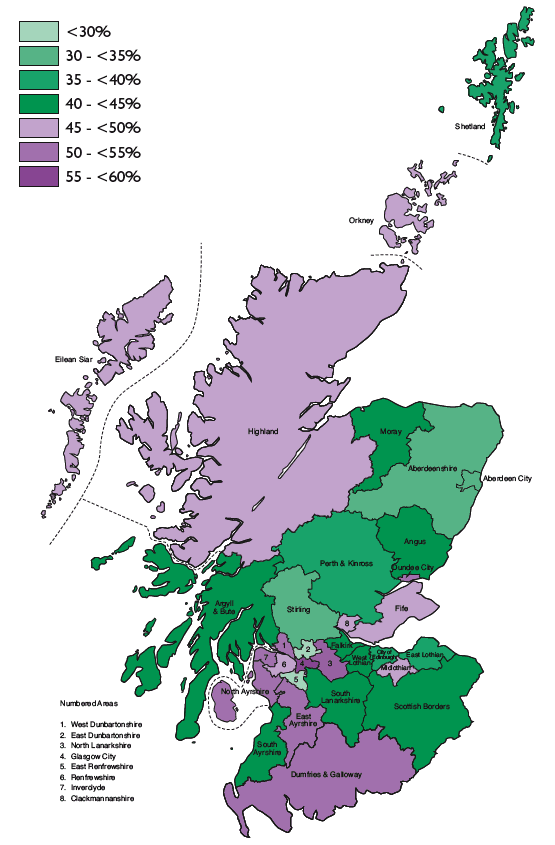
(c) Crown copyright 2008. All rights reserved Scottish Government. Licence number: 100020540 2008.
Source: HM Revenue and Customs and the General Registry Office of Scotland. 5
In all but two local authorities over thirty per cent of children are living in the low income households described in Map 5.1. This is higher than published estimates of child poverty (in 2006-07 twenty-one per cent of children were in relative poverty before housing costs) and so it is advisable not to make direct comparisons between these figures and the national poverty estimate. These figures are useful however for making comparisons between local authorities and over time within the same local authority.
According to these figures Glasgow City has the highest proportion of low income children, followed by West Dunbartonshire, North Ayrshire and Dundee City. Fifty-eight per cent of children in Glasgow are estimated to be living in workless or tax credit dependent households.
Box 5.3: Useful references Income and Poverty statistics website (includes Scottish Households Below Average Income 2006-07, presentations from the recent income statistics user day and other income and poverty data). Scottish Neighbourhood Statistics website (includes small area benefits data): For further information on all Scottish Government statistics: www.scotland.gov.uk/topics/statistics/ Department for Work and Pensions websites: Benefits Tabulation Tool: Family Resources Survey and Households Below Average Income methodology and GB statistics: HM Revenue and Customs website (Tax Credits information and statistics): Office for National Statistics website (includes expenditure statistics): Information on equivalisation (including the equivalence scale used in producing these figures) |
For any information on Scottish income statistics, or comments or suggestions about this publication, please contact the Social Justice Statistics team on 0131 244 0794 or social-justice-analysis@scotland.gsi.gov.uk .
There is a problem
Thanks for your feedback